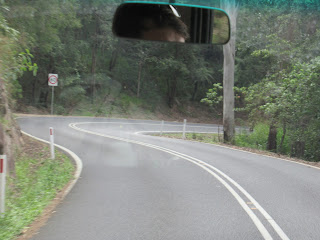Atherton Tablelands
At last I met Skippy on the way to breakfast. He hopped off to join his mates on a green field behind one of the buildings of the hotel. A couple of males were having a fight but I was too absorbed watching them and forgot to take a photo. Neither seemed to win, but they just stopped and went back to eating grass.We drove up the road, crossed a river and started to climb into the Atherton Tablelands, a fertile plateau that forms part of the Great Dividing Range.
It was largely farmland but some trees had been left.
Most of the farmed area was rolling countryside and so was used for grazing rather than for crops.
Another countryside scene.
The Millaa Millaa Falls which are on the Waterfalls Circuit. They are very recognisable as they appear on many websites and have featured in several advertisements and films. It is also the place recorded on a memorial plaque where Christie Palmerston camped on one of his many journeys to discover new tracks and to discover gold.
In the same park is a plaque to commemorate the English family who were instrumental in creating this community. James and Catherine English settled here in 1907 and their nine children were prominent in various areas. They set up several farms and diary herds.
The English family also built multiple buildings in the town and surrounding area such as the Majestic Theatre.
The mosaic.
The town has a modest park named after James May, situated on land that was originally occupied by the railway for the station, goods warehouses and shunting yards.
The plaque that commemorates those pioneering families.
Then it was a short drive to the Lake Eacham Crater Lakes National Park. The lake is fed by rain water but has no in or out flowing streams. It is up to 65 metres deep and has one freshwater crocodile living in it. You can swim in the lake but the freshwater crocodile is not considered dangerous as it is only small and timid so will swim away. But there are warning signs not to confront it or cut off its means of escape.
There is a trail around the shores of the lake with information boards every few hundred metres. Many of the trees have buttresses, aerial roots and strangler vines. Here the path cuts through one of the web of strangler vines.
We stopped at Yungabarra for lunch. The old railway station.
Then it was five minutes down the road to the Curtain Fig National Park.
The strangling fig vine creeps up a parent parent tree and will eventually engulf it and kill it off. Here, the vine killed the parent tree but it collapsed against another tree The vine continued to send down shoots and had created a curtain around both the still upright tree and the original tree which toppled against it. Ultimately, the fig vine will soother the new upstanding tree but that will be several years away. It is a protected site but only until the vine kill the second tree
Then it was a steep and very winding descent off the plateau towards Cairns. The views were great to the naked eye but very difficult to catch on camera.
Looking back at the mountains after the descent from the plateau.
And then we headed along the main road into Cairns.































No comments:
Post a Comment